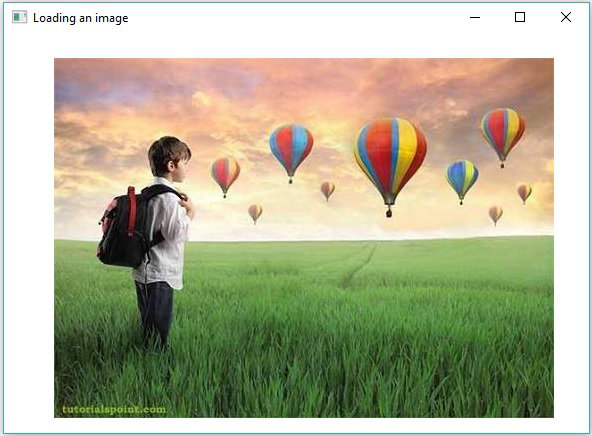
- OpenCV 教程
- OpenCV - 首頁
- OpenCV - 概述
- OpenCV - 環境配置
- OpenCV - 儲存影像
- OpenCV - 讀取影像
- OpenCV - 寫入影像
- OpenCV - 圖形使用者介面
- 繪圖函式
- OpenCV - 繪製圓形
- OpenCV - 繪製直線
- OpenCV - 繪製矩形
- OpenCV - 繪製橢圓
- OpenCV - 繪製折線
- OpenCV - 繪製凸多邊形
- OpenCV - 繪製帶箭頭的直線
- OpenCV - 新增文字
- 濾波
- OpenCV - 雙邊濾波
- OpenCV - 盒狀濾波
- OpenCV - 平方盒狀濾波
- OpenCV - Filter2D
- OpenCV - 膨脹
- OpenCV - 腐蝕
- OpenCV - 形態學操作
- OpenCV - 影像金字塔
- Sobel 導數
- OpenCV - Sobel 運算元
- OpenCV - Scharr 運算元
- 攝像頭和人臉檢測
- OpenCV - 使用攝像頭
- OpenCV - 圖片中的人臉檢測
- 使用攝像頭進行人臉檢測
- OpenCV 有用資源
- OpenCV - 快速指南
- OpenCV - 有用資源
- OpenCV - 討論
OpenCV - 圖形使用者介面
在前面的章節中,我們討論瞭如何使用 OpenCV Java 庫讀取和儲存影像。此外,我們還可以使用 AWT/Swings 和 JavaFX 等 GUI 庫在單獨的視窗中顯示載入的影像。
將 Mat 轉換為 Buffered Image
要讀取影像,我們使用 imread() 方法。此方法以 矩陣 的形式返回讀取的影像。但是,要將此影像與 GUI 庫(AWT/Swings 和 JavaFX)一起使用,應將其轉換為 java.awt.image.BufferedImage 包中的 BufferedImage 類的物件。
以下是將 OpenCV 的 Mat 物件轉換為 BufferedImage 物件的步驟。
步驟 1:將 Mat 編碼為 MatOfByte
首先,您需要將矩陣轉換為位元組矩陣。您可以使用 Imgcodecs 類的 imencode() 方法來實現。以下是此方法的語法。
imencode(ext, image, matOfByte);
此方法接受以下引數:
Ext − 指定影像格式(.jpg、.png 等)的字串引數
image − 影像的 Mat 物件
matOfByte − MatOfByte 類的空物件
使用此方法對影像進行編碼,如下所示。
//Reading the image
Mat image = Imgcodecs.imread(file);
//instantiating an empty MatOfByte class
MatOfByte matOfByte = new MatOfByte();
//Converting the Mat object to MatOfByte
Imgcodecs.imencode(".jpg", image, matOfByte);
步驟 2:將 MatOfByte 物件轉換為位元組陣列
使用 toArray() 方法將 MatOfByte 物件轉換為位元組陣列。
byte[] byteArray = matOfByte.toArray();
步驟 3:準備 InputStream 物件
透過將上一步中建立的位元組陣列傳遞給 ByteArrayInputStream 類的建構函式來準備 InputStream 物件。
//Preparing the InputStream object InputStream in = new ByteArrayInputStream(byteArray);
步驟 4:準備 InputStream 物件
將上一步中建立的 Input Stream 物件傳遞給 ImageIO 類的 read() 方法。這將返回一個 BufferedImage 物件。
//Preparing the BufferedImage BufferedImage bufImage = ImageIO.read(in);
使用 AWT/Swings 顯示影像
要使用 AWT/Swings 框架顯示影像,首先使用 imread() 方法讀取影像,並按照上述步驟將其轉換為 BufferedImage。
然後,例項化 JFrame 類並將建立的緩衝影像新增到 JFrame 的 ContentPane 中,如下所示:
//Instantiate JFrame JFrame frame = new JFrame(); //Set Content to the JFrame frame.getContentPane().add(new JLabel(new ImageIcon(bufImage))); frame.pack(); frame.setVisible(true);
示例
以下程式程式碼演示瞭如何使用 OpenCV 庫讀取影像並透過 Swing 視窗顯示它。
import java.awt.image.BufferedImage;
import java.io.ByteArrayInputStream;
import java.io.InputStream;
import javax.imageio.ImageIO;
import javax.swing.ImageIcon;
import javax.swing.JFrame;
import javax.swing.JLabel;
import org.opencv.core.Core;
import org.opencv.core.Mat;
import org.opencv.core.MatOfByte;
import org.opencv.imgcodecs.Imgcodecs;
public class DisplayingImagesUsingSwings {
public static void main(String args[]) throws Exception {
//Loading the OpenCV core library
System.loadLibrary( Core.NATIVE_LIBRARY_NAME );
//Reading the Image from the file and storing it in to a Matrix object
String file = "C:/EXAMPLES/OpenCV/sample.jpg";
Mat image = Imgcodecs.imread(file);
//Encoding the image
MatOfByte matOfByte = new MatOfByte();
Imgcodecs.imencode(".jpg", image, matOfByte);
//Storing the encoded Mat in a byte array
byte[] byteArray = matOfByte.toArray();
//Preparing the Buffered Image
InputStream in = new ByteArrayInputStream(byteArray);
BufferedImage bufImage = ImageIO.read(in);
//Instantiate JFrame
JFrame frame = new JFrame();
//Set Content to the JFrame
frame.getContentPane().add(new JLabel(new ImageIcon(bufImage)));
frame.pack();
frame.setVisible(true);
System.out.println("Image Loaded");
}
}
執行上述程式後,您將獲得以下輸出:
Image Loaded
此外,您還可以看到一個顯示載入影像的視窗,如下所示:

使用 JavaFX 顯示影像
要使用 JavaFX 顯示影像,首先使用 imread() 方法讀取影像並將其轉換為 BufferedImage。然後,將 BufferedImage 轉換為 WritableImage,如下所示。
WritableImage writableImage = SwingFXUtils.toFXImage(bufImage, null);
將此 WritableImage 物件傳遞給 ImageView 類的建構函式。
ImageView imageView = new ImageView(writableImage);
示例
以下程式程式碼演示瞭如何使用 OpenCV 庫讀取影像並透過 JavaFX 視窗顯示它。
import java.awt.image.BufferedImage;
import java.io.ByteArrayInputStream;
import java.io.IOException;
import java.io.InputStream;
import javafx.application.Application;
import javafx.embed.swing.SwingFXUtils;
import javafx.scene.Group;
import javafx.scene.Scene;
import javafx.scene.image.ImageView;
import javafx.scene.image.WritableImage;
import javafx.stage.Stage;
import javax.imageio.ImageIO;
import org.opencv.core.Core;
import org.opencv.core.Mat;
import org.opencv.core.MatOfByte;
import org.opencv.imgcodecs.Imgcodecs;
public class DisplayingImagesJavaFX extends Application {
@Override
public void start(Stage stage) throws IOException {
WritableImage writableImage = loadImage();
//Setting the image view
ImageView imageView = new ImageView(writableImage);
//Setting the position of the image
imageView.setX(50);
imageView.setY(25);
//setting the fit height and width of the image view
imageView.setFitHeight(400);
imageView.setFitWidth(500);
//Setting the preserve ratio of the image view
imageView.setPreserveRatio(true);
//Creating a Group object
Group root = new Group(imageView);
//Creating a scene object
Scene scene = new Scene(root, 600, 400);
//Setting title to the Stage
stage.setTitle("Loading an image");
//Adding scene to the stage
stage.setScene(scene);
//Displaying the contents of the stage
stage.show();
}
public WritableImage loadImage() throws IOException {
//Loading the OpenCV core library
System.loadLibrary( Core.NATIVE_LIBRARY_NAME );
//Reading the Image from the file and storing it in to a Matrix object
String file ="C:/EXAMPLES/OpenCV/sample.jpg";
Mat image = Imgcodecs.imread(file);
//Encoding the image
MatOfByte matOfByte = new MatOfByte();
Imgcodecs.imencode(".jpg", image, matOfByte);
//Storing the encoded Mat in a byte array
byte[] byteArray = matOfByte.toArray();
//Displaying the image
InputStream in = new ByteArrayInputStream(byteArray);
BufferedImage bufImage = ImageIO.read(in);
System.out.println("Image Loaded");
WritableImage writableImage = SwingFXUtils.toFXImage(bufImage, null);
return writableImage;
}
public static void main(String args[]) {
launch(args);
}
}
執行上述程式後,您將獲得以下輸出:
Image Loaded
此外,您還可以看到一個顯示載入影像的視窗,如下所示:
